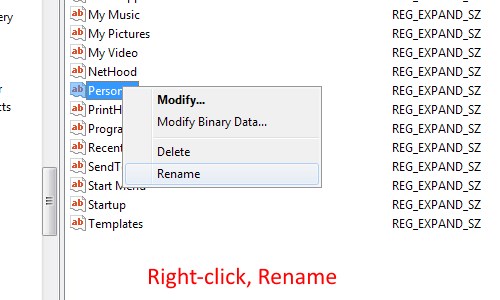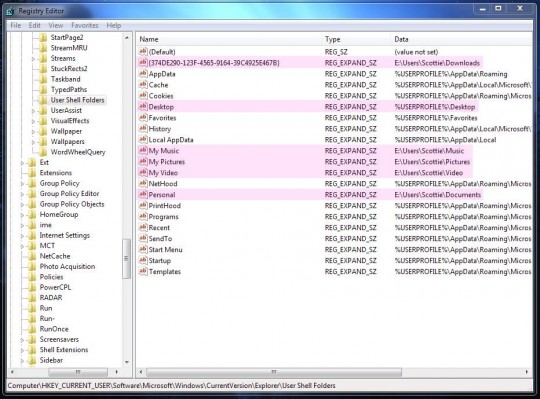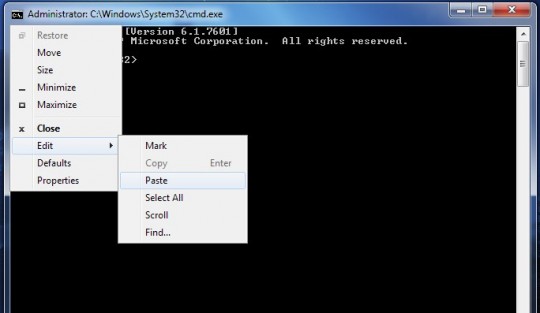At some point, you’ll probably run into a problem that doesn’t seem to have an easy solution: one of your default User folders in Windows 7 (My Documents, My Pictures, My Music, My Videos, Downloads, and Desktop) will suddenly disappear.
Try as you might, you won’t be able to restore these user folders, because they are actually “special”. Windows treats them differently than a normal folder you might create yourself, and they even have pretty icons, like so:

There is a lot of info out there on how to fix these built-in Windows 7 folders, but it’s all rather complicated.
So, here’s the boiled-down, anybody-can-do-it version on how to restore your missing User folders – or so I hope!
First, a few bits of info you’ll need to keep in mind. The default locations for the User folders in Windows 7 are:
- C:\Users\USERNAME\Desktop
- C:\Users\USERNAME\Documents
- C:\Users\USERNAME\Downloads
- C:\Users\USERNAME\Music
- C:\Users\USERNAME\Pictures
- C:\Users\USERNAME\Videos
Just replace USERNAME with your Windows account login, which in my case is “Scottie”. So, my Desktop folder is:
- C:\Users\Scottie\Desktop
These are the actual names of the folders as stored on your hard drive, but since we’re talking about special User folders, they are magically turned into “My ___” folders with the special icon.
So, that’s that. Next, we’re gonna repair your folders. The process will go like this:
- Create/rename the User folders
- Edit the Registry to reset The Magic
- Run some command-prompt stuff to finish The Magic
- Reboot
Don’t worry, it’s all very simple!
Create/Rename the User Folders
So, open Explorer (Win-E, or double-click the Computer icon) and navigate to: C:\Users\USERNAME
Here, you’re going to need to decide which folder(s) are screwed up.
Even though the PATH to the User folder doesn’t contain the word “My”, the version you see in Explorer should look like so:
- Desktop
- My Documents
- Downloads
- My Music
- My Pictures
- My Videos
Note that “Desktop” and “Downloads” do NOT have “My” in front of them in Explorer, but they DO have Magic Folder Icons, which look like so:
If a “magic folder” icon is not there, and it just looks like a regular folder icon, you just need to check the folder name and change it if necessary. If a folder is completely missing, you’ll need to create a new one. Again, the following is the list of folders you may need to create/rename:
- C:\Users\USERNAME\Desktop
- C:\Users\USERNAME\Documents
- C:\Users\USERNAME\Downloads
- C:\Users\USERNAME\Music
- C:\Users\USERNAME\Pictures
- C:\Users\USERNAME\Videos
For example, if you see “My Documents” and it’s a magic icon, you do not need to do anything.
If you see a normal yellow folder called “Documents”, do nothing.
If there is no “My Documents” or “Documents”, then create a new folder C:\Users\USERNAME\Documents.
There are two steps here:
- Check for the Magic Folder Icon
- Check that non-Magic Folders have the proper name, which prepares us for the next step
Maybe only your Downloads folder is screwed up, and all the other folders are okay (Desktop, My Documents, My Music, My Pictures, My Videos). In that case, make sure there is a folder “Downloads”. If there is, go to the next step. If there isn’t, create it first.
Reset the Registry User Folder Settings
This part might seem scary, but it’s really easy.
- Click Start
- Type: regedt32
- Click the program regedt32.exe to run the Registry Editor
- In the left pane, navigate to:
HKEY_CURRENT_USER\Software\Microsoft\Windows\CurrentVersion\Explorer\User Shell Folders
You should see this:
I’ve highlighted the fields you’ll need to look at. You can see that there is one entry for Downloads, one for Desktop, one for My Music, etc. For each folder you need to fix, you’ll want to do 2 things:
- Make sure the Name field is correct (far left, in pink)
- Make sure the Data field is correct (far right, in pink)
Now, in Windows 7, the path C:\Users\USERNAME\ is often written as %USERPROFILE% internally in Windows. This is just a variable that points to your Users directory. Simple, yes? It’s also quite handy.
So, in the Registry Editor, make sure you’re using the default values, like so (Name –> Data):
- {374DE290-123F-4565-9164-39C4925E467B} –> %USERPROFILE%\Downloads
- Desktop –> %USERPROFILE%\Desktop
- My Music –> %USERPROFILE%\Music
- My Pictures –> %USERPROFILE%\Pictures
- My Video –> %USERPROFILE%\Videos
- Personal –> %USERPROFILE%\Documents
Don’t ask me why the Name for Downloads is that wonky string, or why the Name for Documents is “Personal”… It’s Microsoft.
To correct the Name field, right-click the Name and select “Rename”:

To change the Data field (the folder path), double-click the name field, and enter the new path from the list above:

In my example, I don’t want My Documents pointing to E:\Users\Scottie\Documents, because I don’t have E: any more! Oops.
First, I made C:\Users\Scottie\Documents in the steps above.
Now in the Registry Editor, I would not change the Name of “Personal”, since that’s okay according to the list above. But I would double-click it, and change the Data to %USERPROFILE%\Documents
Do the same for any other User folders you need to fix. When you’re done editing, just close the Registry Editor (it saves automatically).
Last crazy step
Now you’re going to complete The Magic. Do this:
- Click Start
- Type: cmd
- Right-click cmd.exe and choose Run as administrator
- For each folder you need to fix or recreate, run the following command(s):
- Downloads:
attrib +r -s -h %USERPROFILE%\Downloads /S /D - Desktop:
attrib +r -s -h %USERPROFILE%\Desktop /S /D - My Documents:
attrib +r -s -h %USERPROFILE%\Documents /S /D - My Music:
attrib +r -s -h %USERPROFILE%\Music /S /D - My Pictures:
attrib +r -s -h %USERPROFILE%\Pictures /S /D - My Videos:
attrib +r -s -h %USERPROFILE%\Videos /S /D
Highlight each “attrib” command you need above, and copy it (Ctrl-C, or right-click and pick Copy). Then, in the Command Prompt window, click the C:\ icon in the upper-left corner and choose Edit -> Paste:
Reboot
That’s it. You’ve made sure your missing folder(s) exist, you’ve done some Registry hacking to reset the Magic Folders, and you’ve set the proper attributes on your new folders.
All that’s left is to reboot! When you log back in, you should see your User folders restored to mint, magical condition.
Final Notes
Hopefully, this has been fairly easy to follow. For other User folders (Contacts) or for Windows 8, check out Seven Forums tutorial on this very topic.
I found their explanation rather difficult to follow, but it does have more information – and even some .REG files you can download and run to avoid doing any registry editing yourself. Check it out!






Excellent tutorial! This is exactly what I needed after accidentally deleting the user “Contacts” folder from my Windows 8.1 set up.
Thanks!
Is this the same for Windows 10. I’ve just messed up my downloads folder on a new laptop and don’t want to reload everything.
Downloads folder shows up in “this PC” as a drive
Thx man, could “rebuild” my Downloads folderwith that tutorial!
I could repair my Documents folder by executing the attrib command. Thanks!
Thanks! the tutorial helped.
But my Desktop folder and my C:\Users\Username location has been merged.
Although all the folders are under the right location, The Desktop folder has replaced my C:\Users\Username under the C:\Users.
I hope someone could help. thanks!
Parameter format not correct –
Error occuring when I try and re create my Documents folder
Correcting or Changing Windows 10 system folders
2018-01-15
We need to break this task up into it’s three component problems.
1) icon 2) folder location and 3) folder name
I think the best approach is the understanding that the key is to first look for the icons. If in This PC you have the icons for each of Desktop, Documents, Downloads, Music, Pictures and Videos, then assume these icons are correct even if everything else is wrong. Then determine which items are wrong, and work on them one by one.
I found that if I navigate to the folder manually from the root of the drive containing the folder I want to use, it makes a huge difference as to understanding what is going on, and the ability to change things.
So there are actually two things to change, not three.
1) icon is the component you don’t change.
Next: 2) change the location of the folder and
Finally: 3) change the name of the folder as shown in This PC -> folders
2) To Change the Location of the Folder
In this case, let’s use the example of changing ‘Pictures’ to ‘David’s Pictures’ in the path of:
D:\OneDrive\Dropbox\Pictures
Create the new folder needed in the drive and path location (D:\OneDrive\Dropbox\) desired with the final name (David’s Pictures) you wish to use. This results in a folder with the path D:\OneDrive\Dropbox\David’s Pictures, as well as the original folder.
Click on: This PC -> Folders -> Pictures -> Right Click -> properties -> Location -> Move
Then navigate to the folder location to change the folder that Pictures was pointing at. Perhaps the most certain way to do it is via the root of the drive needed, e.g. start by scrolling down and selecting the drive, (D:) in this case, then navigate the directory to the folder needed. Note that ‘>’ means to click on the expansion symbol left of the folder shown.
In this example click in sequence:
‘>’ (D:)
‘>’ OneDrive
‘>’ Dropbox
David’s Pictures
Click then and move all items to the new location (i.e. click ).
When complete click on
The Pictures icon folder will now be pointing at the folder you want it to point at, but it may not have the name you want.
3) Change the Name of the Folder as shown in ‘This PC -> folders’
This is a two fold process, a) changing the name in ‘This PC -> folders’ and b) changing the name in the containing folder e.g. D:\OneDrive\Dropbox
a) In this example, to change the name ‘Pictures’ to ‘David’s Pictures’ in ‘This PC -> folders’. Note that ‘>’ means to click on the expansion symbol left of the folder shown.
This PC ->
‘>’ (D:) (the physical name of the drive) ->
‘>’ OneDrive ->
‘>’ Dropbox -> (to expand and see the subfolders in ‘Dropbox’, including the one you wish to change the name, e.g. ‘Pictures’ to ‘David’s Pictures’)
Dropbox ->
Right click on ‘Downloads’ in the RIGHT PANE, (NOTE: changing the name in the left pane will not make any permanent change in ‘This PC -> folders’)
‘Rename’ -> type: ‘David’s Pictures’
If you now select the folder with the new name in the left pane, then select the navigation bar at the top of the window it will show the new name (D:\OneDrive\Dropbox\David’s Pictures), however ‘This PC -> folders’ will still show the old name ‘Pictures’
Restart the computer.
b) Again, navigate via the root of the appropriate drive and go to the new folder you have just set up, in this case:
This PC ->
* You will see that the name in ‘This PC -> folders’ has now changed to the new name, no continue:
‘>’ (D:) (the physical name of the drive) ->
‘>’ OneDrive ->
‘>’ Dropbox ->
However the name in the containing folder D:\OneDrive\Dropbox will still be the old name ‘Pictures’
This time, right click on ‘Downloads’ in the LEFT PANE rather than the right pane
‘Rename’ -> type: ‘David’s Pictures’
The navigation bar at the top of the window will now show the new name ‘D:\OneDrive\Dropbox\David’s Pictures’, matching the name in ‘This PC -> folders’
Restart the computer.
You should now find that in ‘This PC -> folders’ the icon will match the name you selected in this location, and the containing folder location, and if you click ‘This PC -> folders -> David’s Pictures’ you will go to that folder.
from the Gentle Knight
Not sure if your tutorial is what I need. I tried copying (dragging) a very large (30GB) “Music Archive” folder (containing many other folders) from a portable Iomega hard drive (F:), onto a thumb drive (actually a MP3 player). Nothing happened. When I Explored the F:\ drive, the “Music Archive” folder was gone. I found a new folder “Music Archive (G:)” located on my C:\ drive in the computer (Win7 64bit). I’m pretty sure all of my music files have not been erased, since I would have heard the drive working to erase 30GB. But searching the drives would not locate any of the files. Can you help or point me in the right direction?
Hmm… I have no idea. That’s pretty weird!
One more bit of information:
When I click on the new folder found on the C: drive, “Music Archive (G:)”, a message window opens:
“Please insert a disc into Removable Disc (G:)”
(I’ve tried plugging various backup medium into USB ports, but (G:) is never available.)
It sounds like that’s just a shortcut to the external drive. But then, the files should still be there! Have you used the Iomega drive lately? Maybe it (or the disc itself) got corrupted due to age or something…
That “shortcut” was not there before my file (actually multiple folders) copy attempt.
The Iomega drive is good, in use every day. It seems the FAT for that one folder (and all its sub-folders) has been misplaced or omitted, though I know nothing about FAT other than what it stands for.
Thanks for your continued thoughts Scottie!
Not sure if you tried this, but you could right-click the drive, pick Properties, click Tools tab, and then do Error Checking. Maybe it is just some errors on the disc itself that can be repaired. Maybe…
Thanks Scottie, but I tried that already…no errors.
A friend is coming over today with Ubuntu, claiming it has good recovery tools…will see.
Problem solved Scottie!
The files that a Windows search couldn’t find were found with my friend’s Ubuntu disc search.
Thanks for trying to help me!
WOOHOO!! Yup, it figures: linux saved Windows again…
Bless you Scottie. I wish I had found your article at 9 a.m. Wasted my day until I read your instructions and repaired my missing Documents folder. Great. Good man. Thanks
AMAZING! Thank you for this. The path and command prompts work the same for Windows 10 on my new Surface Pro laptop. Easy and intuitive to follow. Thanks again.
I’ve been looking for the solution to this problem for months, and finally with your help I’ve found it. Thank you so much!
thank you thank you it is work 😀
I had a folder under “My Documents” called “My Deliveries”, that simply disappeared.
Can you suggest if the steps above will help locate this missing file?
The “My Documents” file and all other files under that folder are there, no problem. Only the “My Deliveries” folder and sub files have gone missing.
Any help appreciated.
Depending on the version of Windows you have, you might be able to:
1. Right-click My Documents
2. Click Properties
3. Click the Previous Versions tab (if it’s there)
4. Choose a point back in time that will (hopefully) restore the missing folder
Maybe…
Thanks, Scottie. I already tried that. (Windows 7).
Unfortunately, there are no previous versions available.
Any other ideas? So weird. It was not deleted, not in the Trash etc. Just one day it was no longer there.
Hmm… I’m afraid that’s all I got!
Thank you very much for this. Very very helpful.